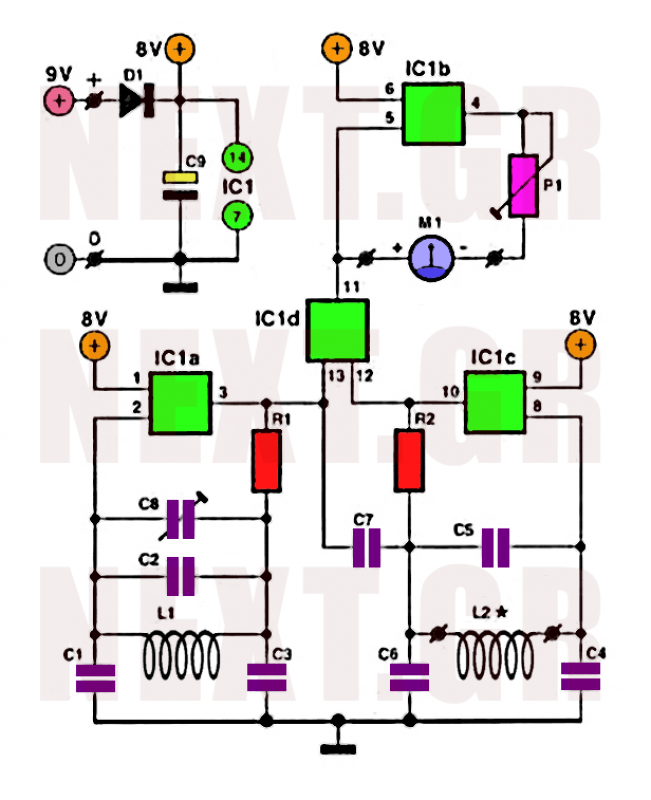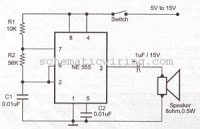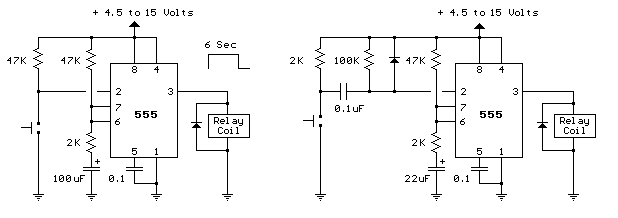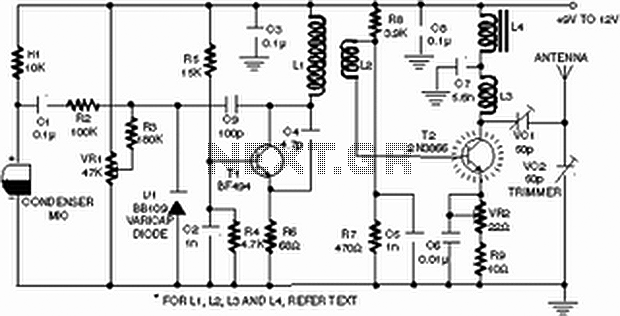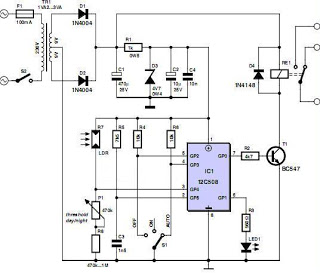
water level indicator circuit schematic
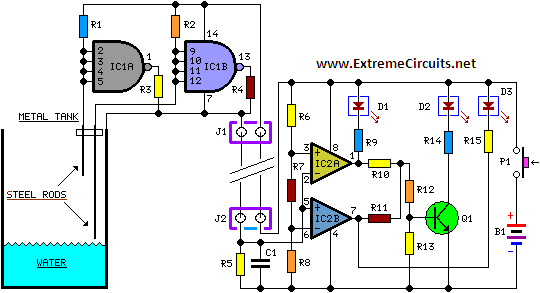
When the water level is below the steel rods, there is no contact between the metal can and the rods, which are supported by a small insulated wooden board. The circuit built around IC1 draws no current, resulting in no voltage drop across resistor R5. IC2A, IC2B, and Q1 are configured as a window comparator. With zero voltage present at input pins #2 and #5, diode D3 will illuminate. When water makes contact with the first rod, pin #13 of IC1 will go high, as input pins #9 to #12 are shorted to negative through the water contact.
The described circuit functions as a water level detection system using a combination of integrated circuits and discrete components. The primary component, IC1, is a multi-functional integrated circuit that serves as a sensor and controller for the system. The steel rods act as probes to detect the water level; when the water level is insufficient, the rods remain isolated, preventing current flow in the circuit.
The circuit operates under the principle of a window comparator, utilizing IC2A and IC2B. This configuration allows the system to monitor voltage levels at specific points. The output of this comparator is linked to transistor Q1, which is responsible for driving the indicator LED, D3. When the water level is low, the lack of voltage at input pins #2 and #5 of IC2 results in the illumination of D3, providing a visual alert of the low water condition.
As the water level rises and makes contact with the first rod, the electrical connection alters the state of IC1. The input pins #9 to #12 of IC1, which were previously grounded, receive a positive voltage due to the conductive nature of water. This change causes pin #13 of IC1 to go high, signaling a change in the circuit's state, which can be used to trigger additional actions, such as activating a pump or sending a signal to a control system.
The inclusion of resistor R5 serves as a current-limiting component, ensuring that the circuit operates safely without excessive current flow that could damage sensitive components. The insulated wooden board provides necessary separation between the rods and the metal can, preventing unintended short circuits and ensuring reliable operation.
Overall, this water level detection circuit is a practical solution for applications requiring monitoring of liquid levels, utilizing simple yet effective electronic components to achieve reliable performance.When the water-level is below the steel rods, no contact is occurring from the metal can and the rods, which are supported by a small insulated (wooden) board. The small circuit built around IC1 draws no current and therefore no voltage drop is generated across R5.
IC2A, IC2B and Q1 are wired as a window comparator and, as there is zero voltage at input pins #2 and #5, D3 will illuminate. When the water comes in contact with the first rod, pin #13 of IC1 will go high, as its input pins #9 to #12 were shorted to negative by means of the water contact..
🔗 External reference
The described circuit functions as a water level detection system using a combination of integrated circuits and discrete components. The primary component, IC1, is a multi-functional integrated circuit that serves as a sensor and controller for the system. The steel rods act as probes to detect the water level; when the water level is insufficient, the rods remain isolated, preventing current flow in the circuit.
The circuit operates under the principle of a window comparator, utilizing IC2A and IC2B. This configuration allows the system to monitor voltage levels at specific points. The output of this comparator is linked to transistor Q1, which is responsible for driving the indicator LED, D3. When the water level is low, the lack of voltage at input pins #2 and #5 of IC2 results in the illumination of D3, providing a visual alert of the low water condition.
As the water level rises and makes contact with the first rod, the electrical connection alters the state of IC1. The input pins #9 to #12 of IC1, which were previously grounded, receive a positive voltage due to the conductive nature of water. This change causes pin #13 of IC1 to go high, signaling a change in the circuit's state, which can be used to trigger additional actions, such as activating a pump or sending a signal to a control system.
The inclusion of resistor R5 serves as a current-limiting component, ensuring that the circuit operates safely without excessive current flow that could damage sensitive components. The insulated wooden board provides necessary separation between the rods and the metal can, preventing unintended short circuits and ensuring reliable operation.
Overall, this water level detection circuit is a practical solution for applications requiring monitoring of liquid levels, utilizing simple yet effective electronic components to achieve reliable performance.When the water-level is below the steel rods, no contact is occurring from the metal can and the rods, which are supported by a small insulated (wooden) board. The small circuit built around IC1 draws no current and therefore no voltage drop is generated across R5.
IC2A, IC2B and Q1 are wired as a window comparator and, as there is zero voltage at input pins #2 and #5, D3 will illuminate. When the water comes in contact with the first rod, pin #13 of IC1 will go high, as its input pins #9 to #12 were shorted to negative by means of the water contact..
🔗 External reference
